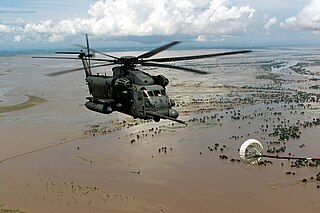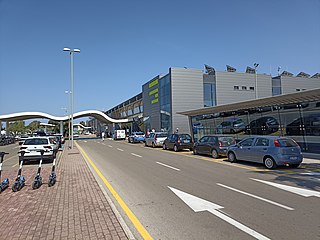History
The original UNHRD depot was inaugurated in Brindisi in the year 2000 to replace the United Nations Supply Depot (UNSD) in Pisa, then managed by the Office of Coordination of Humanitarian Affairs (OCHA). Upon decision of the Inter-Agency Standing Committee (IASC) the mandate to provide rapid and accessible stockpiling and demobilisation services to partners inside and outside the United Nations was transferred from OCHA to WFP. Subsequently, the hub was moved to the military airport at Brindisi in an effort to set up a new and robust logistics platform, available to all partners as a "shared resource".
In 2006, based on its own requirements and that of its partners, WFP replicated the successful Brindisi model by setting up further emergency response facilities in strategic locations worldwide, creating a network of HRDs in Africa, the Middle East, South East Asia and Latin America. Each of these locations has been selected to provide easy access to an airport, port and road systems, making access to a wide range of transportation methods available and allowing for consistently low response times of 24-48 hours.

The World Food Programme (WFP) is an international organization within the United Nations that provides food assistance worldwide. It is the world's largest humanitarian organization and the leading provider of school meals. Founded in 1961, WFP is headquartered in Rome and has offices in 80 countries. As of 2021, it supported over 128 million people across more than 120 countries and territories.

The 2000 Mozambique flood was a natural disaster that occurred in February and March 2000. The catastrophic flooding was caused by heavy rainfall caused by Cyclone Leon-Eline that lasted for four weeks and made many homeless. Approximately 800 people died, 1400 km2 of arable land was affected and 20,000 head of cattle and food were lost. It was the worst flood in Mozambique in 50 years.

A humanitarian crisis is defined as a singular event or a series of events that are threatening in terms of health, safety or well-being of a community or large group of people. It may be an internal or external conflict and usually occurs throughout a large land area. Local, national and international responses are necessary in such events.

Islamic Relief Worldwide is a faith-inspired humanitarian and development agency which is working to support and empower the world's most vulnerable people.

The United Nations Office for the Coordination of Humanitarian Affairs (OCHA) is a United Nations (UN) body established in December 1991 by the General Assembly to strengthen the international response to complex emergencies and natural disasters. It is the successor to the Office of the United Nations Disaster Relief Coordinator (UNDRO).

Disaster response refers to the actions taken directly before, during or in the immediate aftermath of a disaster. The objective is to save lives, ensure health and safety and to meet the subsistence needs of the people affected. This includes warning/evacuation, search and rescue, providing immediate assistance, assessing damage, continuing assistance and the immediate restoration or construction of infrastructure. The aim of emergency response is to provide immediate assistance to maintain life, improve health and support the morale of the affected population. Such assistance may range from providing specific but limited aid, such as assisting refugees with transport, temporary shelter, and food to establishing semi-permanent settlements in camps and other locations. It also may involve initial repairs to damage or diversion to infrastructure.
The Central Emergency Response Fund is a humanitarian fund established by the United Nations General Assembly on December 15, 2005 and launched in March 2006. With CERF’s objectives to 1) promote early action and response to reduce loss of life; 2) enhance response to time-critical requirements; and 3) strengthen core elements of humanitarian response in underfunded crises, CERF seeks to enable more timely and reliable humanitarian assistance to those affected by natural disasters and armed conflicts.

Brindisi Airport, also known as Brindisi Papola Casale Airport and Salento Airport, is an airport in Brindisi, in southern Italy, located 6 kilometres (3.7 mi) from the city center.
Asia Emergency Response Facility (AERF) is a Special Operation of the United Nations World Food Programme, designed to establish an emergency response facility in Asia.
There are a number of meanings for the term humanitarian. Here, humanitarian pertains to the practice of saving lives and alleviating suffering. It is usually related to emergency response whether in the case of a natural disaster or a man-made disaster such as war or other armed conflict. Humanitarian principles govern the way humanitarian response is carried out.

ReliefWeb (RW) is a humanitarian information portal founded in 1996. As of July 2023, it hosts more than one million humanitarian situation reports, press releases, evaluations, guidelines, assessments, maps and infographics. The portal is an independent source of information, designed specifically to assist the international humanitarian community in effective delivery of emergency assistance or relief. It provides information as humanitarian crises unfold, while emphasizing the coverage of "forgotten emergencies" at the same time.
The Consolidated Appeals Process (CAP) is an advocacy tool for humanitarian financing, in which projects managed by the United Nations, NGOs and other stakeholders come together to approach the donor community funding international development activities. The target of the CAP is long-term development, whereas the Central Emergency Response Fund (CERF), started in 2006, targets sudden onset humanitarian crisis such as natural disasters. The 2011 CAP seeks US$7.4 billion to help 50 million people in 28 countries. The 2006 CAP was covered by the donor community to 63%.

The response to the 2010 Haiti earthquake included national governments, charitable and for-profit organizations from around the world which began coordinating humanitarian aid designed to help the Haitian people. Some countries arranged to send relief and rescue workers and humanitarian supplies directly to the earthquake damage zones, while others sought to organize national fund raising to provide monetary support for the nonprofit groups working directly in Haiti. OCHA coordinates and tracks this on a daily basis. The information is disseminated through the UN news and information portal, ReliefWeb. As of September 5, 2013, ReliefWeb have reported a total relief funding of $3.5 billion given.
The Inter-Agency Standing Committee (IASC) is an inter-agency forum of United Nations and non-UN humanitarian partners founded in 1991 to strengthen humanitarian assistance. The overall objective of the IASC is to improve the delivery of humanitarian assistance to affected populations. The Committee was established following UN General Assembly Resolution 46/182 and resolution 48/57 confirmed that it should be the primary method for inter-agency coordination. The committee is chaired by the Emergency Relief Coordinator.

Humanitarian aid during the Syrian civil war has been provided by various international bodies, organizations and states. The main effort is coordinated by Jonh Ging of the United Nations Office for the Coordination of Humanitarian Affairs (UNOCHA). In 2014, U.N. Security Council Resolution 2165 authorised humanitarian aid to be supplied via four border crossings not controlled by the Syrian government, generally to supply rebel-controlled territory.
The Office of U.S. Foreign Disaster Assistance (OFDA) was an organizational unit within the United States Agency for International Development (USAID) charged by the President of the United States with directing and coordinating international United States government disaster assistance. USAID merged the former offices of OFDA and Food for Peace (FFP) in 2020 to form the Bureau for Humanitarian Assistance (BHA).

On the morning of August 14, 2017, significant mudflow events occurred in and around the capital city of Freetown in Sierra Leone. Following three days of torrential rainfall, mass wasting of mud and debris damaged or destroyed hundreds of buildings in the city, killing 1,141 people and leaving more than 3,000 homeless.

Cyclonic Storm Sagar was the strongest tropical cyclone to make landfall in Somalia and Somaliland in recorded history until Gati in 2020, and the first named cyclone of the 2018 North Indian Ocean cyclone season. Forming on May 16 east of the Guardafui Channel, Sagar intensified into a cyclonic storm on the next day, as it gradually organized. The storm turned to the west-southwest and traversed the entirety of the Gulf of Aden, making landfall over Somaliland on May 19, farther west than any other storm on record in the North Indian Ocean. Sagar weakened into a remnant low on May 20.
The 2019–2020 Congo River floods resulted from torrential rains from October 2019 to January 2020 that caused the overflow of the Congo and Ubangi rivers, floods and landslides throughout the Democratic Republic of Congo (DRC) and Republic of Congo (RoC) and led to the displacement of hundreds of thousands of people.

Many countries allocated relief aid items to southern Africa after Cyclone Freddy, with a main focus on the humanitarian crisis in Malawi. Items included hygiene supplies, food rations, and safe drinking water among other things Total donations reach the millions in USD, and there was also a primary focal point on the historic and ongoing outbreak of Cholera in the region. Several nations also expressed condolences to Malawi, Mozambique, and Madagascar. The widespread and prolonged impacts prompted extensive relief efforts from the affected nations and multiple intergovernmental agencies. UNICEF and the WFP provided relief items for those affected, as well as temporary shelters.












